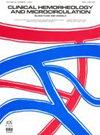评估诊断意义:利用弹性成像和对比增强超声波对乳腺病变进行鉴别诊断。
IF 2.1
4区 医学
Q3 HEMATOLOGY
引用次数: 0
摘要
目的本研究的主要目的是评估弹性成像和对比增强超声波(CEUS)在通过传统超声波优化和修正 BI-RADS 第 4 类分类后识别乳腺病变方面的诊断效果。目的是提高乳腺病变诊断的特异性和准确性,从而建立一个可靠的框架,减少临床上不必要的活检。方法在 2022 年 11 月至 2023 年 11 月期间收集了 50 例 BI-RADS 第 4 类乳腺病变病例。利用应变弹性成像(SE)、剪切波弹性成像(SWE)和 CEUS 对这些病例进行了检查。本次调查制定了超声弹性成像(UE)和 CEUS 的新评分方法。随后,所开发的 UE 和 CEUS 评分系统被用于完善和优化传统的 BI-RADS 分类,无论是单独使用还是结合使用。根据修订后的分类,良性组被归为第 3 类,疑似恶性组被归为第 4a 类及以上,病理结果作为最终参考标准。以病理结果为参考标准,采用接收器操作特征曲线(ROC)分析法对优化后的 UE 和 CEUS 的独立和组合诊断效果进行了细致的检查和比较。在实施优化标准之前,78%的患者(50 例中有 39 例)接受了不必要的活组织检查。采用优化标准后,特别是 UE 评分方法的阈值≥8.5 分和 CEUS 评分方法的阈值≥6.5 分,不必要活检的发生率明显降低。UE方案的降低率为53.8%(39人中有21人),CEUS方案的降低率为56.4%(39人中有22人),UE和CEUS联合优化方案的降低率为89.7%(39人中有35人)。联合方案的应用显著降低了不必要活检的发生率。本文章由计算机程序翻译,如有差异,请以英文原文为准。
Evaluating diagnostic significance: The utilization of elastography and contrast-enhanced ultrasound for differential diagnosis in breast lesions.
OBJECTIVE
The primary aim of this study is to assess the diagnostic efficacy of elastography and contrast-enhanced ultrasound (CEUS) in the identification of breast lesions subsequent to the optimization and correction of the BI-RADS category 4 classification obtained through conventional ultrasound. The objective is to augment both the specificity and accuracy of breast lesion diagnosis, thereby establishing a reliable framework for reducing unnecessary biopsies in clinical settings.
METHODS
A cohort comprising 50 cases of breast lesions classified under BI-RADS category 4 was collected during the period from November 2022 and November 2023. These cases were examined utilizing strain elastography (SE), shear wave elastography (SWE), and CEUS. Novel scoring methodologies for ultrasonic elastography (UE) and CEUS were formulated for this investigation. Subsequently, the developed UE and CEUS scoring systems were used to refine and optimize the conventional BI-RADS classification, either in isolation or in conjunction. Based on the revised classification, the benign group was classified as category 3 and the suspected malignant group was classified as category 4a and above, with pathological results serving as the definitive reference standard. The diagnostic efficacy of the optimized UE and CEUS, both independently and in combination, was meticulously scrutinized and compared using receiver operating characteristic (ROC) curve analysis, with pathological findings as the reference standard.
RESULTS
Within the study group, malignancy manifested in 11 cases. Prior to the implementation of the optimization criteria, 78% (39 out of 50) of patients underwent biopsies deemed unnecessary. Following the application of optimization criteria, specifically a threshold of≥8.5 points for the UE scoring method and≥6.5 points for the CEUS scoring method, the incidence of unnecessary biopsies diminished significantly. Reduction rates were observed at 53.8% (21 out of 39) with the UE protocol, 56.4% (22 out of 39) with the CEUS protocol, and 89.7% (35 out of 39) with the combined UE and CEUS optimization protocols.
CONCLUSION
The diagnostic efficacy of conventional ultrasound BI-RADS category 4 classification for breast lesions is enhanced following optimized correction using UE and CEUS, either independently or in conjunction. The application of the combined protocol demonstrates a notable reduction in the incidence of unnecessary biopsies.
求助全文
通过发布文献求助,成功后即可免费获取论文全文。
去求助
来源期刊
CiteScore
4.30
自引率
33.30%
发文量
170
期刊介绍:
Clinical Hemorheology and Microcirculation, a peer-reviewed international scientific journal, serves as an aid to understanding the flow properties of blood and the relationship to normal and abnormal physiology. The rapidly expanding science of hemorheology concerns blood, its components and the blood vessels with which blood interacts. It includes perihemorheology, i.e., the rheology of fluid and structures in the perivascular and interstitial spaces as well as the lymphatic system. The clinical aspects include pathogenesis, symptomatology and diagnostic methods, and the fields of prophylaxis and therapy in all branches of medicine and surgery, pharmacology and drug research.
The endeavour of the Editors-in-Chief and publishers of Clinical Hemorheology and Microcirculation is to bring together contributions from those working in various fields related to blood flow all over the world. The editors of Clinical Hemorheology and Microcirculation are from those countries in Europe, Asia, Australia and America where appreciable work in clinical hemorheology and microcirculation is being carried out. Each editor takes responsibility to decide on the acceptance of a manuscript. He is required to have the manuscript appraised by two referees and may be one of them himself. The executive editorial office, to which the manuscripts have been submitted, is responsible for rapid handling of the reviewing process.
Clinical Hemorheology and Microcirculation accepts original papers, brief communications, mini-reports and letters to the Editors-in-Chief. Review articles, providing general views and new insights into related subjects, are regularly invited by the Editors-in-Chief. Proceedings of international and national conferences on clinical hemorheology (in original form or as abstracts) complete the range of editorial features.

 求助内容:
求助内容: 应助结果提醒方式:
应助结果提醒方式:


